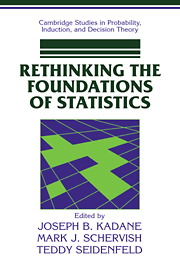Book contents
- Frontmatter
- Contents
- Introduction
- PART 1 DECISION THEORY FOR COOPERATIVE DECISION MAKING
- PART 2 THE TRUTH ABOUT CONSEQUENCES
- PART 3 NON-COOPERATIVE DECISION MAKING, INFERENCE, AND LEARNING WITH SHARED EVIDENCE
- 3.1 Subjective Probability and the Theory of Games
- 3.2 Equilibrium, Common Knowledge, and Optimal Sequential Decisions
- 3.3 A Fair Minimax Theorem for Two-Person (Zero-Sum) Games Involving Finitely Additive Strategies
- 3.4 Randomization in a Bayesian Perspective
- 3.5 Characterization of Externally Bayesian Pooling Operators
- 3.6 An Approach to Consensus and Certainty with Increasing Evidence
- 3.7 Reasoning to a Foregone Conclusion
- 3.8 When Several Bayesians Agree That There Will Be No Reasoning to a Foregone Conclusion
- Index of Names
- Subject Index
3.6 - An Approach to Consensus and Certainty with Increasing Evidence
Published online by Cambridge University Press: 05 June 2012
- Frontmatter
- Contents
- Introduction
- PART 1 DECISION THEORY FOR COOPERATIVE DECISION MAKING
- PART 2 THE TRUTH ABOUT CONSEQUENCES
- PART 3 NON-COOPERATIVE DECISION MAKING, INFERENCE, AND LEARNING WITH SHARED EVIDENCE
- 3.1 Subjective Probability and the Theory of Games
- 3.2 Equilibrium, Common Knowledge, and Optimal Sequential Decisions
- 3.3 A Fair Minimax Theorem for Two-Person (Zero-Sum) Games Involving Finitely Additive Strategies
- 3.4 Randomization in a Bayesian Perspective
- 3.5 Characterization of Externally Bayesian Pooling Operators
- 3.6 An Approach to Consensus and Certainty with Increasing Evidence
- 3.7 Reasoning to a Foregone Conclusion
- 3.8 When Several Bayesians Agree That There Will Be No Reasoning to a Foregone Conclusion
- Index of Names
- Subject Index
Summary
ABSTRACT
We investigate conditions under which conditional probability distributions approach each other and approach certainty as available data increase. Our purpose is to enhance Savage's (1954) results, in defense of “personalism”, about the degree to which consensus and certainty follow from shared evidence. For problems of consensus, we apply a theorem of Blackwell and Dubins (1962), regarding pairs of distributions, to compact sets of distributions and to cases of static coherence without dynamic coherence. We indicate how the topology under which the set of distributions is compact plays an important part in determining the extent to which consensus can be achieved. In our discussion of the approach to certainty, we give an elementary proof of the Lebesgue density theorem using a result of Halmos (1950).
INTRODUCTION
In his classic discussion of Bayesian inference, L. J. Savage (1954, Sections 3.6 and 4.6) illustrates how (finitely many) different investigators come to agree on the truth of one hypothesis, given an increasing sequence of shared observations. More precisely, Savage's result is this. Assume the following two conditions.
1. The agents' initial opinions over a (finite) set of rival hypotheses are not too discrepant – there is agreement on which hypotheses have probability 0.
2. There is agreement also on the (distinct) likelihoods for these hypotheses over an infinite sequence of observations which are identically, independently distributed given an hypothesis.
- Type
- Chapter
- Information
- Rethinking the Foundations of Statistics , pp. 333 - 348Publisher: Cambridge University PressPrint publication year: 1999

